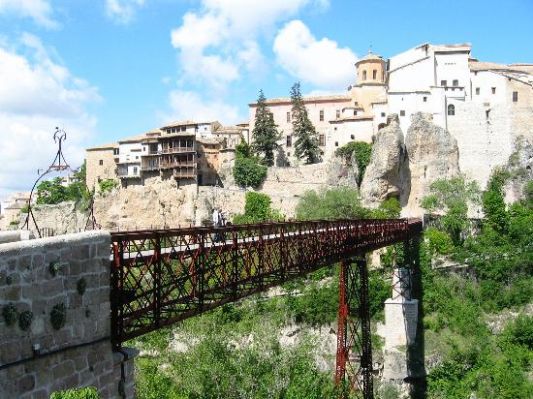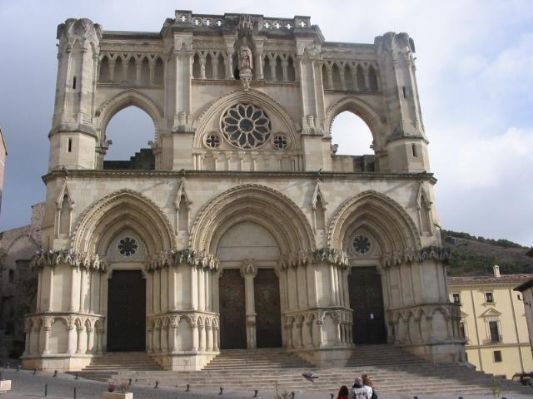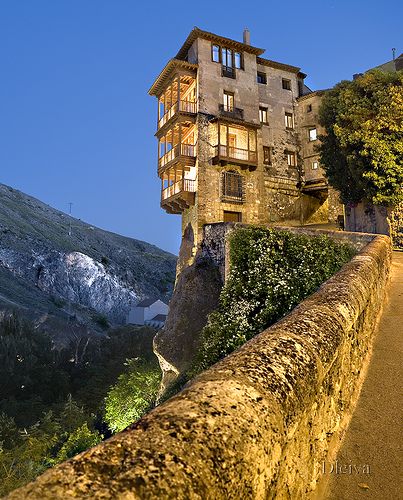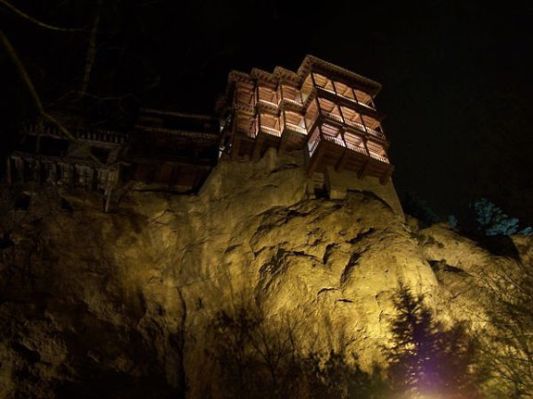.jpg)
The Old Town of Cuenca is an exceptional example of the medieval fortress town that has preserved its original townscape intact, along with many examples of religious and secular architecture from the 12th to 18th centuries. The walled town blends into and enhances the fine rural and natural landscape within which it is situated.
Cuenca is an ensemble, Islamic in origin, which reached its greatest splendour during the medieval and Renaissance centuries, when Cuenca had a leading place among the towns belonging to the Castilian crown. Cuenca is a 'fortress town' where the architecture conforms to the natural landscape, resulting in a cultural heritage of universal value. It may be considered a prototype of the 'landscape town'. The lack of space within the walls, along with the need to straddle the river valleys, has resulted an unusual development of the vernacular architecture, with exceptional groups on the cliffs overlooking the river Huécar and the Júcar.
When the Moors conquered Spain they took advantage of one of the best defensive sites on the lberian peninsula, to build a fortress-town from which to control the vast area of the Kura de Kunka, in the heart of the Caliphate of Córdoba. It developed between the castle and the Alcázar, adapting itself to the terrain.
Alfonso VIII of Castille captured the town in 1177 and Cuenca entered a new phase of its history as a "Royal town" and consequently Christian. The Christian town was built over the Moorish one and began to spread down from the crest of the hill. lt became a manufacturing town and one of the nuclei of the Castilian economy as well as an administrative centre.
During the 16th century Cuenca experienced a large increase in population, which tripled to some sixteen thousand by 1594. The intra-muros area was gradually taken over by religious institutions, the wealthier citizens moving to the lower parts of the town and the common people to new suburban areas. This was the period of Cuenca's flowering, with a large textile industry and flourishing trade.
The urban fabric stabilised itself at this time, not to change significantly until the present century: the fortified upper town is a closed and densely settled medieval urban space, the lower town open and ordered. The early 17th century saw the collapse of the textile industry and an economic crisis. Only the ecclesiastical element of the town survived relatively unscathed and continued to build: Cuenca became a monastic town and Baroque architecture began to appear in the townscape but the town underwent a period of deterioration: ancient buildings either collapsed or were demolished because they were unsafe. The historic fortified enclosure was virtually abandoned by its wealthier residents and became a largely working class and monastic area.
The rehabilitation plan of 1918 accomplished very little beyond the widening of some of the streets and restoration of some facades. The upper town is the archetype of the fortress-town, and the part that gives Cuenca its individual character. The Castillo quarter is a small suburb just outside the walls, with vernacular houses. From here the fortified town is reached by a bridge.

Some remains of the Moorish fortress still survive, among the large aristocratic houses, monasteries, and churches along San Pedro and Trabuco streets, from the medieval, Renaissance and Baroque periods. The 12th-century cathedral, built on the site of the former Great Mosque and the first Gothic cathedral in Spain with its Plateresque chapels, is located on the Plaza Mayor, which is also the site of the Town Hall and the Petras convent. Its churches and monastic ensembles are notable artistic features of Cuenca.

Most were founded early in the town's history and underwent many transformations and additions over the centuries that followed. The private houses near the Episcopal Palace were built in the later medieval period on the spectacular steep bluffs overlooking the bend of the Huécar River. Most of them were rebuilt in the 16th century in their present narrow, high form, with two or three rooms on each of three or more floors. These houses are what have made Cuenca so popular as a tourist attraction, commonly known as the "Hanging Houses of Cuenca".


The importance of the upper town lies, however, not so much in its individual buildings, although many of these are of outstanding architectural and artistic quality, as in the townscape that they create when looked at as a group, on the fortified site dominating the river valleys. It is this which gives Cuenca its special character and quality.
Ver mapa más grande